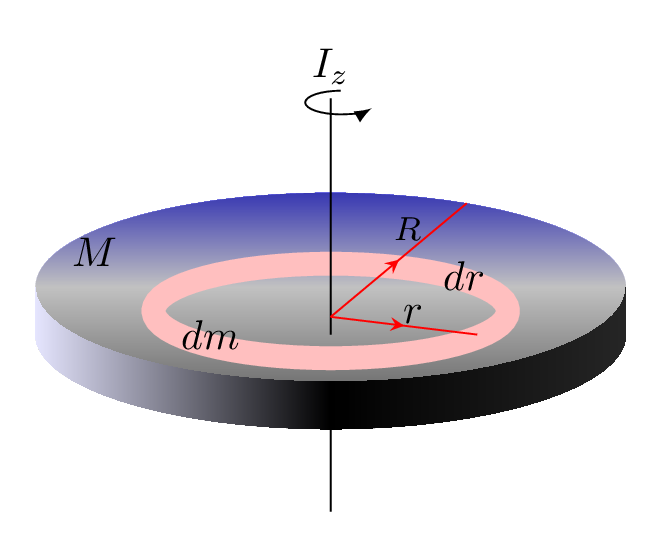Subsection 7.1.5 Moment of Inertia of a Disk



Subsubsection 7.1.5.1 About an axis passing through its center of mass and perpendicular to its plane
Consider a disk of radius \(R\) and mass \(M\) is rotating about an axis passing through its center of mass and perpendicular to its plane [Figure 7.1.6.(a)]. To find the moment of inertia of such a disk consider an elementary ring of radius \(r\text{,}\) thickness \(\,dx\text{,}\) and mass \(\,dm\) then the moment of inertia of this elementary ring (annulus) is given by
\begin{equation*}
\,dI = \,dm r^{2}
\end{equation*}
\begin{equation*}
\text{or,}\quad I = \int \,dI = \int\limits_{0}^{R}\left(\frac{M}{\pi R^{2}}(2\pi r\,dr)\right)r^{2}
\end{equation*}
\begin{equation*}
\because \text{mass of a ring} =(\text{mass per unit area of a disk})\cdot (\text{area of a ring})
\end{equation*}
\begin{equation*}
\text{or,}\quad I = \frac{2M}{R^{2}}\int\limits_{0}^{R}\left(r^{3}\,dr\right)
\end{equation*}
\begin{equation*}
=\frac{2M}{R^{2}}\left.\frac{r^{4}}{4}\right\vert_{0}^{R}
\end{equation*}
\begin{equation*}
=\frac{M}{2R^{2}}(R^{4}-0)=\frac{1}{2}MR^{2}
\end{equation*}
Subsubsection 7.1.5.2 About an axis through its diameter
Using perpendicular axis theorem, [Figure 7.1.6.(b)]
\begin{equation*}
I_{z}=I_{x}+I_{y}
\end{equation*}
\begin{equation*}
\text{But}\quad I_{z}=I_{cm}=\frac{1}{2}MR^{2}
\end{equation*}
and by symmetry,
\begin{equation*}
I_{x}=I_{y}
\end{equation*}
\begin{equation*}
\therefore\quad I_{z}=2I_{x} \Rightarrow\quad I_{x}=\frac{I_{z}}{2}= \frac{1}{4}MR^{2}
\end{equation*}
Subsubsection 7.1.5.3 About an axis passing through its edge and perpendicular to its plane
Using parallel axis theorem, [Figure 7.1.6.(c)]
\begin{equation*}
I_{edge}=I_{cm}+Md^{2}=\frac{1}{2}MR^{2} +MR^{2}= \frac{3}{2}MR^{2}
\end{equation*}
